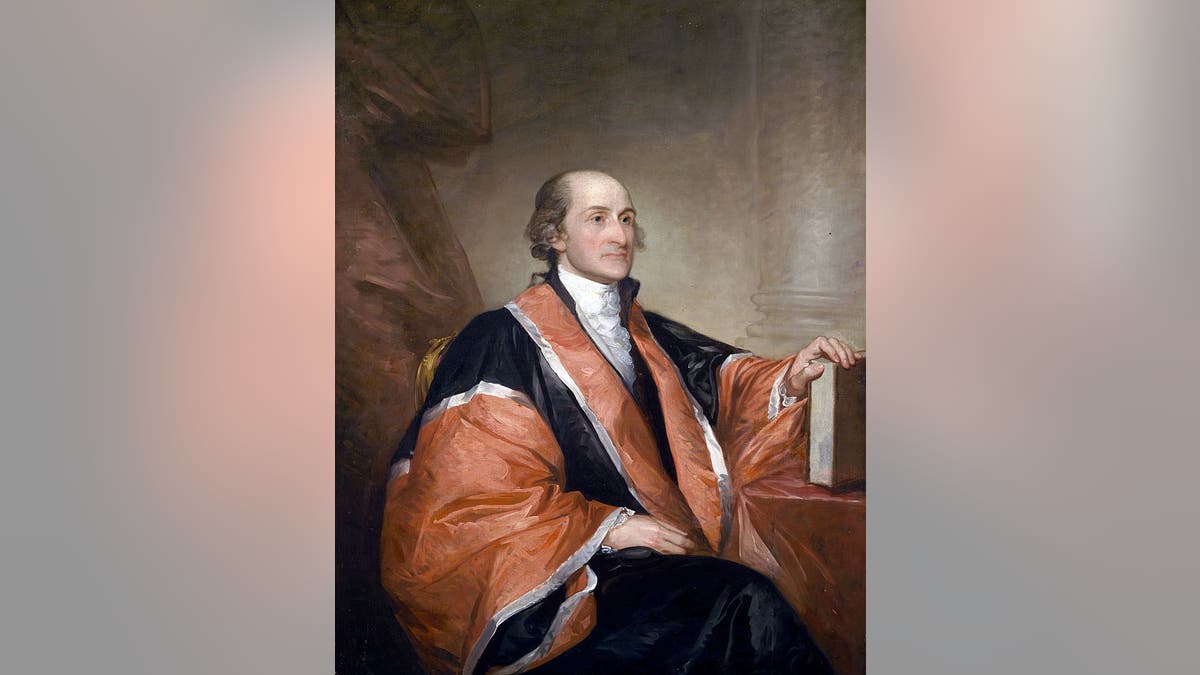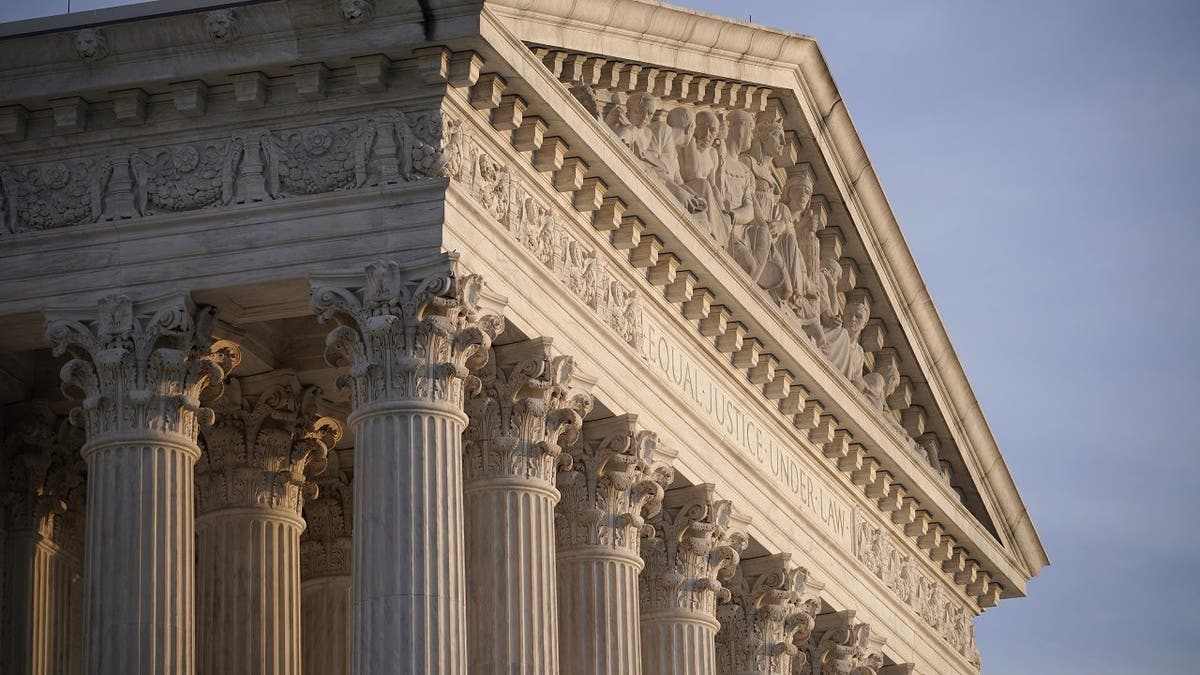Biden says Supreme Court will decide when COVID-19 emergency is over
President Biden told reporters, ""The Covid emergency will end when the Supreme Court ends it."
The Supreme Court of the United States assembled for the first time at the Old Merchants Exchange in New York City on this day in history, Feb. 1, 1790.
"The Constitution granted the Supreme Court ultimate jurisdiction over all laws, especially those in which their constitutionality was at issue," writes History.com of the founding of the judicial branch.
"The high court was also designated to oversee cases concerning treaties of the United States, foreign diplomats, admiralty practice and maritime jurisdiction."
Chief Justice John Jay of New York led the court proceedings.
He was joined by five associate justices: John Blair of Virginia, William Cushing of Massachusetts, James Iredell of North Carolina, John Rutledge of South Carolina and James Wilson of Pennsylvania.

John Jay (1745-1829), an American statesman, patriot, diplomat, one of the Founding Fathers and the first Chief Justice of the United States of America. Painted by Gilbert Stuart (1755-1828), American painter; 18th century. (Universal History Archive/Universal Images Group via Getty Images)
The Constitution deems that the number of justices is determined by Congress.
The Supreme Court did not take its familiar form of nine members until 1869.
The early court suffered numerous indignities, including a lack of a permanent home; the dangerous practice of "riding circuit" around the country amid primitive travel conditions; and a dependence on the other two branches for its formation.
"The judicial power of the United States, shall be vested in one supreme court and in such inferior Courts as the Congress may from time to time ordain and establish," the Founding Fathers wrote in Article III, Section 1 of the U.S. Constitution.
"The Constitution elaborated neither the exact powers and prerogatives of the Supreme Court nor the organization of the Judicial Branch." — SupremeCourt.gov
However, the Founders were not rich on the details of the high court.
"The Constitution elaborated neither the exact powers and prerogatives of the Supreme Court nor the organization of the Judicial Branch as a whole," the Supreme Court reports in its own online history.
"Thus, it was left to Congress and to the justices of the court through their decisions to develop the federal judiciary and a body of federal law."
George Washington was sworn in as the first chief executive on April 30, 1789. He nominated Jay to the chief justice position on Sept. 24.

An engraving of the site of the first Supreme Court, the Old Merchants Exchange in Manhattan, circa 1790. (Fotosearch/Getty Images)
"John Jay [occupied] more high offices than any other Founding Father, including president of the Second Continental Congress, secretary of foreign affairs under the Articles of Confederation, and, most famously, the Supreme Court’s first chief justice," writes the National Portrait Gallery.
ON THIS DAY IN HISTORY, OCTOBER 19, 1789, JOHN JAY SWORN IN AS FIRST SUPREME COURT JUSTICE
"Washington saw Jay as unique in his superior virtue and objectivity and appointed him chief justice with great confidence in his qualifications."
The Senate unanimously confirmed Jay on Sept. 26.
Congress met for the first time at New York City’s Federal Hall (where Washington was sworn in) on March 4 of that year.
It also went to work carving out the shape of the judicial branch.
"The first bill introduced in the United States Senate became the Judiciary Act of 1789. The act divided the country into 13 judicial districts, which were, in turn, organized into three circuits: the Eastern, Middle, and Southern," the Supreme Court notes.

The Supreme Court of the United States in Washington, D.C. The high court did not have its own dedicated home until 1935. (AP Photo/J. Scott Applewhite, File)
"For the first 101 years of the Supreme Court’s life — but for a brief period in the early 1800s — the Justices were also required to ‘ride circuit,’ and hold circuit court twice a year in each judicial district."
CLICK HERE TO SIGN UP FOR OUR LIFESTYLE NEWSLETTER
The court spent its first year working on organizational proceedings.
It heard its first cases in 1791, by then meeting in Philadelphia, and handed down its first opinion in the case of West v. Barnes on Aug. 3, 1791.
The court ruled 5-0 in favor of David L. Barnes against farmer and former Revolutionary War general William West, both from Rhode Island, in a mortgage dispute.
"Justices faced dangers, illness and harsh living conditions as circuit riders." — National Park Service
In a testament to the rugged nature of the young republic, the Merchants Exchange, which housed the first meetings of the Supreme Court, had to be cleared of butchers and livestock before the justices could convene.
The Supreme Court, shockingly, would not have its own dedicated home until 1935 — a sense of third-rate treatment among the three branches that began to fester in the earliest days of the judiciary.

Headshot portrait of American jurist James Iredell (1751-99), portrait circa 1790s. An Englishman by birth, he became a lawyer, political essayist and North Carolina statesman. Nominated by President George Washington, Iredell was approved by the Senate to the post of associate justice of the Supreme Court and served from 1790-99. (Engraving by Albert Rosenthal/Kean Collection/Getty Images)
"The first Justices complained of the Court’s limited stature; they were also concerned about the burdens of ‘riding circuit’ under primitive travel conditions," the court states in its online history.
"Fatigue, road hazards, separation from family and poor living conditions defined life for the early Justices like James Iredell, who described his high position as ‘severe,’" writes the National Park Service.
"Justices faced dangers, illness and harsh living conditions as circuit riders. Justices spent anywhere from six to nine months on circuit, averaging some 1,000 miles for each circuit. In 1792, Justice Iredell suffered a road accident where he injured his leg. He was later robbed while riding circuit."
CLICK HERE TO GET THE FOX NEWS APP
He died two weeks after turning 48 years old, "worn down by his judicial duties."
The practice of "riding circuit" was soon amended, but it continued until it was abolished by the Judicial Code of 1911.
For more Lifestyle articles, visit www.foxnews.com/lifestyle.


